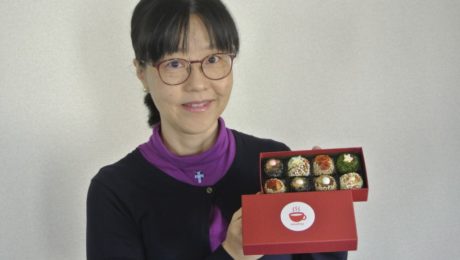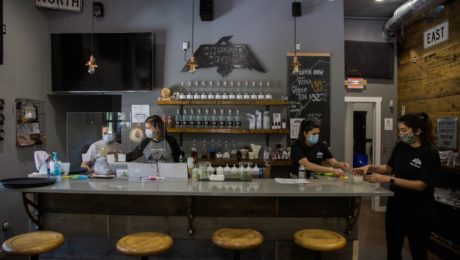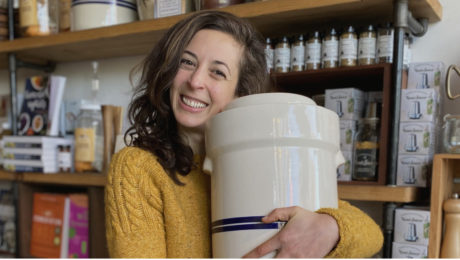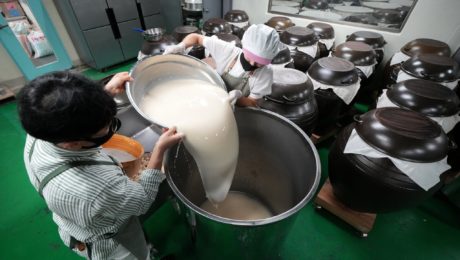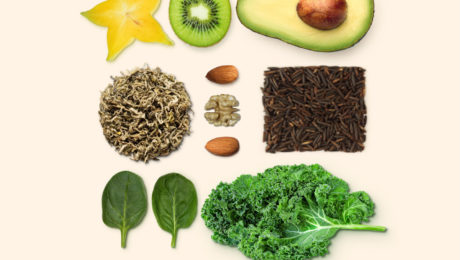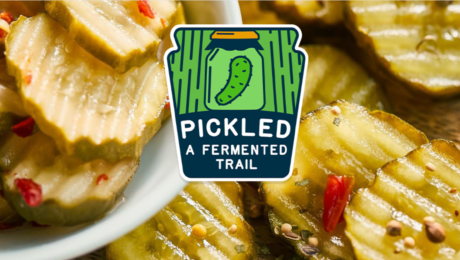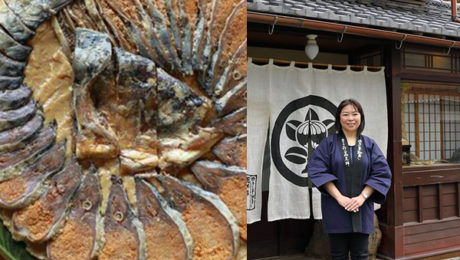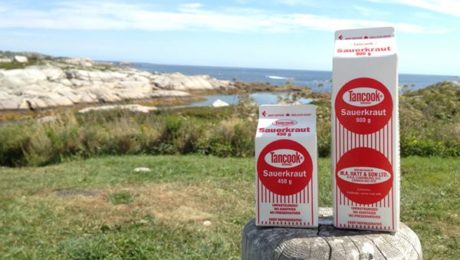Preserving Japan’s Miso Culture
A Japanese public-relations-exec-turned-chef has developed a unique product — Miso Drops, individually-sized servings of stock. She felt it was difficult for an individual customer to use miso from traditional breweries because they only ship products weighing at least 500 grams. Her drops weigh around 26 grams.
Entrepreneur Motomi Takahashi, “alarmed by the gradual disappearance of small-scale miso breweries that have been a key part of Japan’s tradition of fermented foods,” created the soybean paste balls using traditional methods. And, different from the large factories that mass-produce miso products, Takahashi’s miso drops are handmade.
Important to Takahashi is preserving Japan’s rich miso culture. Small-scale miso brewing in the country is “in danger of extinction,” notes an article in Kyodo News. In Japan’s Nagano Prefecture, where most of the miso in the country is made, the number of miso breweries declined 42% from 1963-2010.
Takahashi is developing a product line called misodrop47, which will feature miso drops made in each of Japan’s 47 prefectures. Currently, hermiso drops come from eight.” I wanted to develop products for the misodrop47 project to allow customers to casually sample miso from all over Japan,” she says.
Read more (Kyodo News)
- Published in Business, Food & Flavor
Whey-Based Spirits
Wisconsin-based Native American distillery Copper Crow is using whey to make vodka and gin. Whey (the liquid byproduct of cheesemaking) gives the liquors a creamy, sweet, sake-like taste.Copper Crow one of only a handful of distilleries in the world that makes whey-based spirits.
Whey can be difficult to dispose of. Every pound of cheese leaves behind nine pounds of whey, but it cannot be poured down a drain or into farm fields because it consumes oxygen. Many cheesemakers use it for animal feed or fertilizer.
“The market for the protein-rich, lactose-clouded liquid is minuscule — mostly makers of workout snacks and wellness tonics — but distillers represent a small yet emerging new customer base, with American producers beginning to follow the lead of those in the U.K., France, Australia, and New Zealand,” reads an article on Copper Crow in Fortune.
Copper Crow sits on the Red Cliff Reservation, with Lake Superior artesian aquifers providing pristine water. Owners Curtis and Linda Basina are members of the Red Cliff Band of the Lake Superior Chippewa. Prohibition laws from 1834, though, barred Native Americans from trading alcohol on their reservations.So it would be illegal to run a distillery on their reservation.
The Bassinas found a loophole to the racially-motivated ban — they own title to the land where the distillery is located. Their application was approved, “a watershed moment for Native American entrepreneurs long denied a slice of a booming craft-distilling industry.”
Read more (Fortune)
- Published in Business, Food & Flavor
San Francisco’s Growing Chocolate Scene
In San Francisco, a “booming Bay Area confection ring” is developing.. Julia Street, a former food tech industry exec, is the latest entrant. She is now a self-taught chocolatier running J Street Chocolate.
Street began pursuing chocolate “to follow her obsession with all things fermented.” The experimental chocolates “only a scientist could dream up” are made using upcycled ingredients from other fermenters in the city. For example, she uses spent grains from Laughing Monk Brewing in her Piv Snack Bars. She tells Eater that the ethics behind the chocolate are important to her, too. Her 68% cacao bar is sourced from the Dominican Republic, and sales support a Northern Dominican agroforestry project.
Other Bay Area chocolate shops that have cropped up in recent years include Dandelion Chocolate, Topogato and Kokak Chocolates.
Read more (Eater)
- Published in Business, Food & Flavor
Korean Rice Wine Gets a Makeover
Makgeolli made the pages of The New York Times, hailed as a “cosmopolitan sensation over the past decade…the buzz grew during Covid lockdowns.”
The Korean rice wine is a centuries-old tradition in Korea. Makgeolli (or makkolli) is made from fermented rice and nuruk (a dough-like starter). But the drink’s had a difficult history in the country. It was banned during Japan’s 35-year occupation of the Korean Peninsula, then suppressed again in the 50’s during a postwar grain shortage.
“For the people that grew up in postwar Korea, their understanding of makgeolli and soju is very different from what the general population of Koreans understood in prewar,” says Alice Jun, the New York-based makgeolli producer behind Hana Makgeolli. Jun studied the craft in Seoul before starting her artisanal brand in Brooklyn.
The makgeolli industry used to be run by larger companies until about 10 years ago. Now smaller start-ups are leading the industry, and young Korean professionals are driving demand for the drink.
“It’s not that we’re taking a new approach to things,” Jun said of her brand and the makgeolli start-ups that are proliferating in South Korea. “It’s that we’re appreciating the traditional things, and calling attention to them in the world of the internet and social media and brands.”
Read more (The New York Times)
- Published in Business, Food & Flavor
Fermented Foods Top 2022’s Superfood List
For the fifth year in a row, fermented foods again top the Today’s Dietitian annual list of superfoods.
The 10th annual What’s Trending in Nutrition survey “reveals a wave of change resulting from the pandemic.” Public relations firm Pollock Communications, who conducted the survey for the magazine, surveyed 1,173 Registered Dietitian Nutritionists (RDNs) about trends for 2022. The “most surprising change from the past decade,” RDNs agreed, was “the shift from low-carb to high-fat diets…followed by plant-based eating.”
Health- and immunity-boosting food “will be the biggest trend in the next decade that will shape changes in the food industry.” Immunity support, affordability and emotional well-being are consumers’ top purchase drivers; convenience, healthy, taste, low-cost and natural are the top label attributes.
The label attribute “healthy” first made the top three list in 2019 “as consumers began to better understand the connection between food and overall well-being.” RDNs say the Covid-19 pandemic accelerated the healthy food trend.
“With the focus on health and immunity in the next decade, and the increased popularity of plant-based eating, nutrient-dense options will be an important part of consumer diets, as [consumers]embrace food as medicine to help prevent disease,” says Louise Pollock, president of Pollock Communications. “In addition, there will likely be an increased interest in functional foods containing ingredients that provide health benefits beyond their nutrient profile.”
Consumer desire for gut-boosting benefits pushed fermented foods to #1 on the list. Changes to the top 10 show salmon is out and ancient giants are in.
“The predictions of RDNs, the frontline experts in food and nutrition, are always reliable to help food and beverage manufacturers and marketers meet the demands of consumers. Our survey has accurately tracked health and wellness trends for a decade,” says Mara Honicker, publisher of Today’s Dietitian. “We are pleased to have been able to share these insights for the past ten years and especially during this chaotic time in our lives, when food is playing such a major role in providing health, wellness and emotional support.”
The full superfoods list is:
- Fermented foods, like yogurt and kefir
- Blueberries
- Seeds, like chia and hemp
- Exotic fruit, like acai and golden berries
- Avocados
- Green tea
- Nuts
- Ancient grains
- Leafy greens, like spinach
- Kale
To read all the takeaways from the 2022 survey, check out the Pollock Communications press release.
- Published in Food & Flavor, Health
Fermentation Tourism
The state of Pennsylvania has created a unique tourist experience, Pickled: A Fermented Trail. The self-guided, culinary tour showcases fermented food and drink from around the state.
The fermented trail is broken into five regional itineraries, and includes historic businesses, artisanal food makers and large producers. Stops range from an Amish gift shop that ferments root beer to a master chocolatier, from a kombucha taproom to a fermentation-focused restaurant, and from a fourth-generation cheesemaker to a convenience store that makes its own pickles, sauerkraut and vinegar. Mary Miller, cultural historian and professor, spent two years designing the trail.
“Cultured foods have been part of PA’s culinary culture since the beginning,” reads the Visit Pennsylvania Pickled: A Fermented Trail website. “Many groups that have migrated to Pennsylvania throughout history were fond of fermented foods for both health and flavor, as well as for preserving food through the winter.”
The website also features a history of fermented food and drink, both regionally and globally. It shares a brief overview of root beer, which was created in Pennsylvania as a sassafras-based, yeast-fermented root tea. And it notes that, while Germans brought sauerkraut to the state, the Chinese are believed to have been the first to ferment cabbage.
The fermented trail is one of Pennsylvania’s four new culinary road trips, along with those highlighting charcuterie, apples and grains. These paths aim to showcase the state’s culinary history, and preserve its foodways.
This unique culinary adventure — the first we have seen at TFA — could be a model for tourism in other states and countries.
Read more (Food & Wine)
- Published in Business
Kombucha for the Skin
Will 2022 be the year of fermented cosmetics? Market research firm WGSN thinks so. As consumers continue to desire natural cosmetics and Korean and Japanese skincare products, fermentation is a leading trend in the cosmetics industry.
Consumers want to protect their skin from environmental stresses and restore skin’s youthful glow and use potent ingredients that last longer, both factors fermentation addresses. WGSN calls the fermented beauty trend as “kombucha for the skin”
“…fermentation releases enzymes that break down molecules so they can better penetrate the skin, delivering powerful ingredients into the very structure of the skin or hair. The process of fermentation also cultivates the growth of beneficial bacteria such as lactic, organic and acetic acids, which act as natural preservatives,” according to WGSN. “These naturally occurring bacterias prolong the shelf life of formulas, appealing to both the sustainably minded and value-focused consumer.”
Smaller, niche brands already offer cosmetics using fermented ingredients. Gallinée’s hair cleansing cream is enriched with fermented rice water and Innisfree makes fermented soy masks.
Read more (Premium Beauty News)
- Published in Business
2022 Alt Meat Trends & Challenges
“The landscape of cell-cultured meat, and even microbially fermented animal products, is a complicated place where futuristic technology, ethics, the law and business are all approaching the unknown together,” reads a Forbes article.
There are at least 60 companies globally now involved with cell- and fermentation-grown meat, and nearly a billion dollars was invested in the field in 2021 alone.
Animal-free meat, though, is facing growing pains. Forbes shares the trends and challenges in the rapidly-growing alternative protein industry. Some of their predictions and observations:
- Accelerator and incubator programs will help new companies start.
- Startups lead the pack, influencing larger companies to invest in their own animal-free lines.
- Truly animal-free options, as companies develop proprietary methods that don’t require animal input.
- Knowledge sharing, the trend that more companies will not gatekeep their intellectual property.
- Production of all “meats,” rather than just beef and chicken. (Companies are developing animal-free foie gras, fish maw and even zebra.)
- Alt breast milk, using stem cells.
- Cheaper products, as the higher prices of alternative proteins keep some consumers away.
- Regulatory challenges, as regulatory agencies debate terminology and labeling requirements.
Read more (Forbes)
- Published in Business
Fermented Sushi
In Japan, one family has been making funazushi — the ancient, fermented predecessor to modern sushi — for 18 generations. Instead of using raw fish, funazushi uses fish aged for three years.
The funazushi-making process at Kitashina — which opened in 1619 in the small Japanese town Takashima — is labor intensive. A chef removes the fish’s scales and, without cutting into its flesh, removes the gills and innards through its throat. The fish is then packed with salt, layered in a wooden tub, weighted with over 65 pounds of stones and left to cure for two years. Then the fish is rinsed, dried in the sun for a day and fermented for another year before being ready to eat.
The microorganisms in the wooden tubs (called kioke) “naturally produce the fermentation that gives Kitashina’s funazushi its authentic flavour.” Mariko Kitamura (pictured), family owner of Kitashina , says those beneficial microorganisms would die if the tubs were ever emptied.
Though modern sushi includes ocean seafood, funazushi uses fresh water fish, particularly funa (carp). The fermented sushi technique is an adaptation of what has been used in China for thousands of years. The Chinese make narezushi using the freshwater fish that live in rice paddies.
Read more (BBC)
- Published in Food & Flavor
Pandemic Closes 75-Year-Old Sauerkraut Producer
Beloved Canadian sauerkraut brand Tancook is shutting down after 75 years. The iconic Nova Scotia traditional sauerkraut, which is packaged in a milk carton, was even the subject of Philip Moskovitz’s book Adventures in Bubble and Brine: What I Learned from Nova Scotia’s Masters of Fermented Foods, Craft Beer, Cider, Cheese, Sauerkraut, and More.
Owners Hatt and Son Ltd. announced the closure on social media, posting “due to financial implications of the Covid-19 pandemic, we have made the difficult decision to end production.” Owner Cory Hatt said “difficult decisions” had to be made and he did not want to discuss it further with media outlets.
Tancook’s history is rich in Canada. German immigrants found that cabbage thrived on Nova Scotia’s Big Tancook Island, where they fertilized it annually with seaweed. Tancook sauerkraut became a popular condiment for seafaring ships, who would pick up barrels of it to combat scurvy in sailors and provide them nutrition during long, maritime winters.
Tancook Brand Sauerkraut was later produced commercially in Lunenburg County in Nova Scotia, using the same recipe brought from the island by the great-grandfather of Hatt. It remained a traditionally fermented product.
A social media campaign has already launched, aiming to find a buyer for the brand.
Read more (CBC)
- Published in Business

